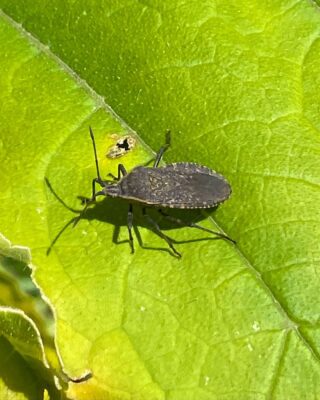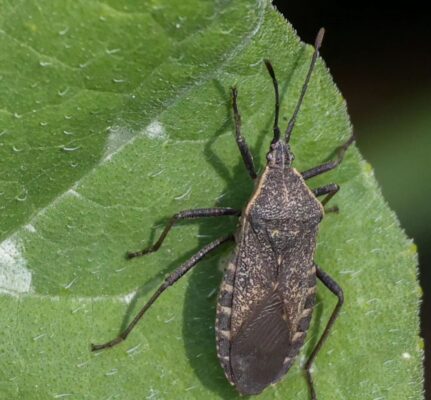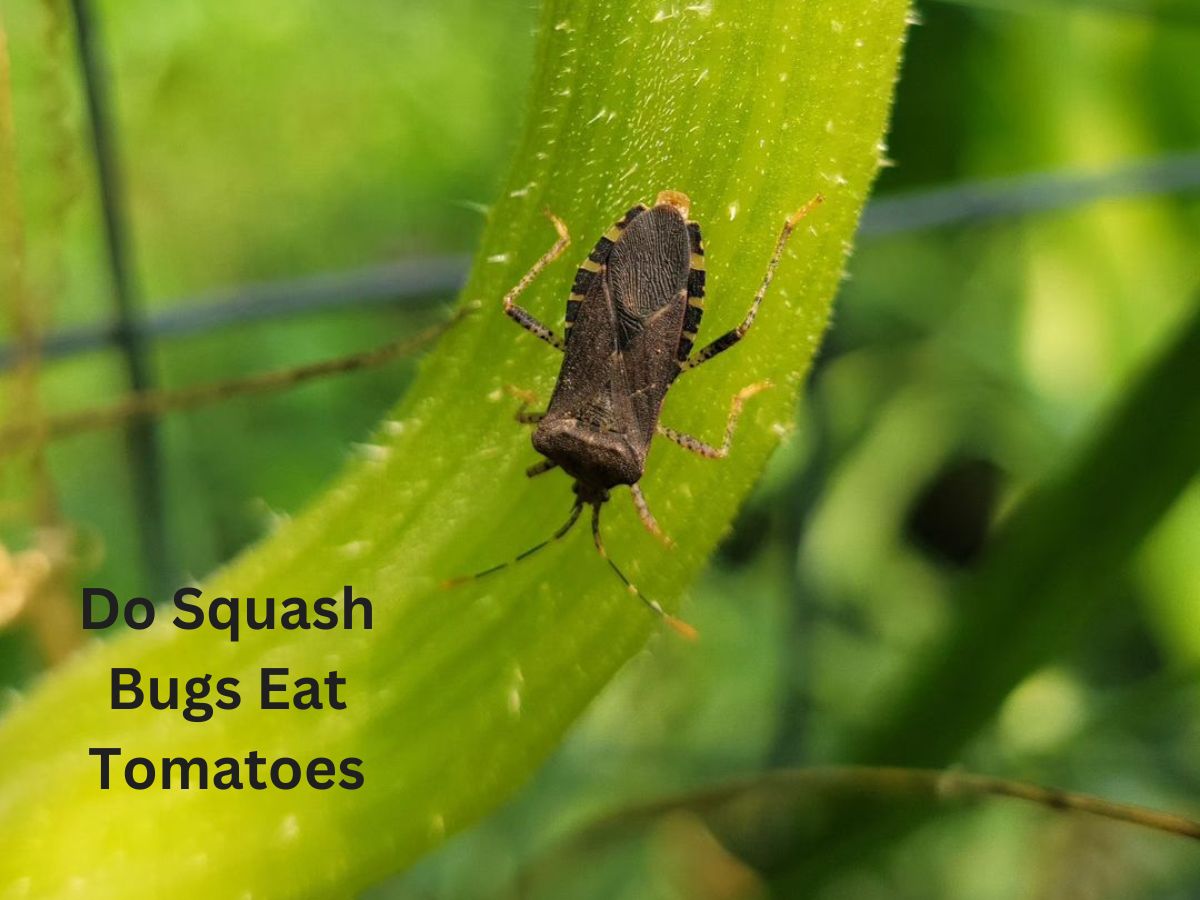the world of gardening, where every leaf tells a story and every pest has a role to play. Amidst the green tapestry of your garden, a question often flits through the minds of both seasoned cultivators and those just getting their hands dirty: Do squash bugs eat tomatoes?
Imagine ripe tomatoes nestling amidst the foliage, their vibrant hues tempting both gardeners and pests alike. But fear not, for as we venture into the heart of this inquiry, we’re armed with answers. The short answer? Not quite. While squash bugs are notorious for their affinity for cucurbit plants, like zucchinis and pumpkins, tomatoes don’t quite make it to the top of their menu.
You see, squash bugs are the connoisseurs of the cucurbit family. Their specialized mouthparts are tailor-made for sipping from these plants. Tomatoes, however, belong to a different plant family altogether, one that doesn’t quite tickle the taste buds of these persistent bugs.
In this article, we’re embarking on a journey to decode the intricate relationship between squash bugs and tomatoes. We’ll explore the nuances of their feeding habits, decipher the indirect impacts, and arm you with practical strategies to ensure your tomato treasures remain unscathed. So, fellow gardeners, let’s untangle the web of curiosity and cultivate a deeper understanding of whether these squash bugs truly have a penchant for tomatoes.
What Are Squash Bugs?
Let’s begin our journey by acquainting ourselves with these enigmatic garden invaders known as squash bugs. Imagine a shield-shaped insect, sporting shades of brown or gray, with a distinct flat-backed body – that’s the quintessential squash bug (Anasa tristis).
Found predominantly in warm climates, these stealthy creatures are most active during the balmy summer months. Their habitats range from backyard gardens to sprawling farms, making them a familiar presence for anyone nurturing plant life.
Now that we’ve met our squiggly protagonists, it’s time to delve into their culinary preferences. While you might envision a buffet of various plant offerings, squash bugs are quite discerning in their choices.
Their diet of choice predominantly features plants in the cucurbit family, including the likes of squash, pumpkins, cucumbers, and melons. These plants have a certain allure for squash bugs, with their enticing scents and flavors that seem irresistible to these tiny, voracious feeders.

Plant Damage Caused by Squash Bugs
In the intricate ballet of the garden, every creature plays a role. Some, like pollinators, bestow blessings upon our plants, while others, like squash bugs, bring a more challenging tune to the performance.
As these shield-shaped insects grace your garden, they can inflict a unique form of damage that requires your attention and intervention. Let’s delve into the visual symphony of plant damage caused by squash bugs and discover the cues that demand your response.
- Wilted Leaves and Stunted Growth: Picture the lush green foliage of your beloved plants slowly wilting, as if the life force within them were slipping away. This is a hallmark of squash bug feeding. As these pests insert their needle-like mouthparts into the stems and leaves of your plants, they extract sap, depleting essential fluids. This feeding weakens the plant’s ability to transport water and nutrients, resulting in wilting leaves and, eventually, stunted growth.
- Yellowing and Discoloration: As the damage intensifies, your plants might take on a sickly hue, showing signs of yellowing or browning. This discoloration occurs due to the disruption in nutrient uptake caused by squash bug feeding. Leaves may lose their vibrant green, signaling distress and affecting the plant’s overall vitality.
- Premature Leaf Drop: Imagine your garden adorned with leaves that seem to surrender prematurely, carpeting the ground like autumn leaves in the wrong season. Squash bug infestations can cause leaves to drop before their time, robbing the plant of its photosynthetic powerhouses and hindering its ability to produce energy.
- Deformed Fruits: In some cases, the damage inflicted by squash bugs can extend beyond the leaves. As these pests feed, their activities can lead to distorted or misshapen fruits. Your once-perfect tomatoes might bear the scars of their presence, manifesting as irregular growth patterns or uneven ripening.
- Presence of Eggs on Undersides: In their quest for reproduction, squash bugs lay clusters of small, bronze-colored eggs. These eggs are often found on the undersides of leaves, a telltale sign of an impending infestation. Their presence serves as a stark reminder that squash bugs have set their sights on your garden; here is how to get rid of them.
In the dance of plant damage caused by squash bugs, vigilance is your greatest ally. Regular inspection of your garden allows you to detect these signs early, allowing you to take action.
Implementing integrated pest management strategies, such as manual removal, beneficial insects, and natural repellents, empowers you to safeguard your plants and maintain the harmonious rhythm of your garden’s narrative.
The Tomato Plant’s Susceptibility
In the lush tapestry of a garden, tomato plants stand as both treasures and targets. Adored for their flavor and versatility, these vibrant gems can be quite the temptation for various pests. As we explore the delicate dance between tomato plants and their potential pests, we unravel the story of vulnerability and resilience.
Tomatoes possess a charm that transcends human admiration – their succulent fruits carry an aroma that wafts through the air, beckoning creatures far and wide. Unfortunately, this allure extends to pests as well. The tender foliage and juicy bounty of tomato plants can make them susceptible to a variety of insects seeking their share of the feast. Aphids, whiteflies, and even the notorious hornworms are among the contenders vying for a taste.
However, let’s not forget that tomatoes aren’t entirely defenseless. Nature, in its wisdom, equips these plants with a subtle arsenal. Tomato plants are known to produce compounds like alkaloids and glycoalkaloids that can act as natural repellents against certain pests. These chemical defenses create a barrier, deterring pests from making a meal of the foliage.
Enter the enigma of squash bugs – those renowned aficionados of squash and pumpkin plants. While tomatoes may not be their first love, the question remains: Could they develop a taste for the tomato’s offerings? The potential risk lies in the fact that these bugs share the same garden or farm setting as tomatoes. As they traverse the foliage in search of their preferred meals, squash bugs might inadvertently explore tomato plants, drawn by their scent and succulence.
In this delicate balance of nature’s cravings and defenses, gardeners play a pivotal role. By understanding the traits that attract or repel pests and the dynamics of coexistence, they can make informed choices in cultivation and pest management. Our journey continues as we dig deeper into the specifics of squash bugs and their curious relationship with the world of tomatoes. Stay with us as we uncover the secrets hidden within the leaves and unveil the intricacies of this garden tale.
Can Squash Bugs Eat Tomatoes?
Let’s cut to the chase – the burning question on every gardener’s mind: Can squash bugs truly sink their needle-like mouthparts into the juicy flesh of tomatoes? The straightforward answer is this: Squash bugs are not known for their keen interest in tomatoes.
Their preferred menu consists mainly of plants from the cucurbit family, such as squashes, pumpkins, and cucumbers. So, while they might explore a tomato plant out of curiosity, their primary culinary focus lies elsewhere.
Squash Bugs’ Attraction to Tomato Plants
As we decipher the subtle nuances of nature’s intricacies, it’s worth considering whether tomato plants have any allure for these shield-shaped insects. Tomato leaves, while not as appealing to squash bugs as their beloved cucurbits, do emit certain scents that might pique their interest.
However, these fragrances are typically not strong enough to make tomatoes a top choice on their menu. Instead, squash bugs are more likely to be drawn to the familiar aroma of squash vines and pumpkin leaves.
Occasional Feeding on Tomatoes
Now, here’s the intriguing twist: While squash bugs may not be die-hard tomato enthusiasts, there are instances where they might indulge in a tomato snack. Picture this scenario – a garden in which their favored cucurbit plants are in short supply.
In such cases of scarcity, squash bugs might venture onto nearby tomato plants as an alternative source of sustenance. It’s a survival strategy, a way to quell their hunger when their preferred options are limited.
However, it’s important to note that such instances are exceptions rather than the norm. Tomato plants, despite their occasional inclusion in the squash bug diet, are not their primary focus. These bugs possess specialized mouthparts designed for feeding on the sap of cucurbit plants, and tomatoes simply don’t provide the same level of appeal.
As we navigate through the intriguing world of pest preferences and garden dynamics, remember that understanding the nuances of these interactions empowers us to create a harmonious and thriving garden. So, while the thought of squash bugs nibbling on your tomatoes might linger in the background, rest assured that these crimson treasures are more likely to shine brightly on your dinner table than in the eyes of these curious critters.

Preventing Squash Bug Infestations
Maintaining a thriving garden is akin to orchestrating a symphony of growth and harmony. When it comes to safeguarding your cherished tomato plants from the potential menace of squash bugs, a proactive approach is your best strategy. Here are some practical tips to create an unwelcoming environment for these critters:
- Strategic Plant Placement: Spacing is not just a matter of aesthetics – it’s a defense strategy. Plant your tomatoes and squash plants with ample space between them. This natural separation makes it less likely for squash bugs to migrate from one plant to the other, reducing the risk of infestations.
- Companion Planting: Embrace the power of botanical partnerships. Intermingle your tomato plants with herbs like basil and marigolds. These fragrant companions confuse the scent-seeking squash bugs, making them less likely to identify and target your tomatoes.
- Crop Rotation: Rotate your crops annually to keep squash bugs guessing. By changing the location of your tomato and squash plants, you disrupt the bugs’ familiar territory, potentially deterring them from settling in.
- Mulching Magic: A layer of organic mulch not only conserves moisture but also acts as a barrier. It makes it harder for squash bugs to traverse the terrain and reach your tomato plants.
- Consistent Inspection: Develop the habit of regular garden patrols. Be vigilant in checking the undersides of leaves for the telltale signs of squash bug eggs. Early detection allows for swift action before an infestation gains momentum.
- Physical Barriers: For smaller gardens or container plantings, consider using row covers or fine mesh netting. These barriers act as protective shields, preventing squash bugs from accessing your tomato plants altogether.
- Early Planting: Get a head start on the growing season. By planting your tomato crops early, you establish a healthier and more resilient foundation that can better withstand potential pest pressures.
- Healthy Soil Management: Strong plants are less susceptible to attacks. Nurture your soil with compost and organic matter, providing a nutrient-rich foundation that promotes vigorous plant growth and heightened pest resistance.
- Trap Crops: Consider planting a sacrificial “trap” crop of squash or pumpkins a distance away from your main tomato patch. This diversionary tactic lures squash bugs away from your tomatoes, effectively protecting your precious crop.
- Manual Removal: A hands-on approach can be surprisingly effective. Regularly inspect your tomato plants and remove any squash bugs or eggs you find. This proactive strategy prevents their population from spiraling out of control.
- Water Management: Maintain a consistent watering schedule that keeps your tomato plants healthy without creating excessively moist conditions. Squash bugs thrive in humid environments, so striking a balance is key.
- Pruning and Airflow: Prune the lower leaves of your tomato plants to increase airflow and reduce the humidity that squash bugs adore. A well-ventilated garden bed is less inviting to these pests.
- Beneficial Nematodes: Introduce beneficial nematodes to your soil. These microscopic organisms prey on squash bug larvae, providing a natural form of pest control.
- Diatomaceous Earth: Dust a thin layer of food-grade diatomaceous earth around the base of your tomato plants. This natural substance pierces the exoskeletons of pests, causing them to dehydrate and perish.
- Natural Sprays: Create a homemade insecticidal soap or neem oil spray. These natural concoctions can repel or smother squash bugs while being less harmful to the environment.
Remember, the goal is to create an environment where your tomato plants thrive while keeping potential pests at bay. By implementing these preventive measures, you empower yourself as the guardian of your garden – a role that ensures the flourishing of your tomatoes without the lurking shadow of squash bug infestations.
Remember, gardening is a dynamic dance, and no single strategy guarantees complete immunity from pests. Combining multiple preventive methods increases your chances of maintaining a thriving tomato patch free from the clutches of squash bug infestations. Adapt, observe, and fine-tune your approach as you navigate the journey of nurturing your garden oasis.
Expert Advice and Insights
Horticulture experts weigh in on the intriguing dynamics between squash bugs and tomato plants:
- Dr. Emily Greenfield, a renowned entomologist, shares, “While squash bugs may occasionally nibble on tomato plants, it’s important to remember that their primary preference lies with cucurbit crops. Vigilance and a proactive approach to pest management can effectively minimize any potential impact on your beloved tomatoes.”
- John Martinez, a seasoned horticulturist, emphasizes, “Understanding the nuances of pest behavior is crucial. Plant diversity, companion planting, and maintaining a healthy garden ecosystem can tip the scales in favor of plant resilience.”
Balancing Pest Management and Plant Health
As we navigate the delicate equilibrium of gardening, the concept of integrated pest management emerges as a guiding principle. Dr. Susan Anderson, a respected figure in the field, enlightens us: “Integrated pest management (IPM) is about finding harmony between pest control and plant health. By combining preventive measures, beneficial organisms, and careful use of interventions, we strike a balance that preserves the vibrancy of our gardens.”
Indeed, the harmony lies in a holistic approach. Recognizing that pests are an intrinsic part of the garden landscape, we shift our perspective from eradication to regulation. As gardeners, we become stewards, orchestrating an intricate dance where tomatoes flourish and pests find their ecological niche.
So, as you navigate the realm of tomato cultivation, heed these insights from experts who advocate for knowledge-driven action. Embrace the wisdom of balance, for it’s through this lens that your garden transforms into a vibrant tapestry of coexistence and growth – a testament to the beauty of nature’s intricate symphony.
Do Squash Bugs Eat Tomatoes FAQs?
Can squash bugs transmit diseases to tomatoes?
No, squash bugs themselves do not directly transmit diseases to tomatoes. However, their feeding habits can weaken tomato plants, making them more susceptible to various diseases.
The stress caused by an infestation can compromise the plant’s immune system, increasing the likelihood of secondary infections. To prevent disease transmission, focus on maintaining the overall health of your tomato plants and implementing proper pest management strategies.
Are there companion plants that deter squash bugs?
Absolutely; Companion planting can play a significant role in deterring squash bugs from your tomato plants. Certain aromatic herbs like basil, catnip, and tansy have been known to repel squash bugs due to their strong scents.
Marigolds are another excellent companion, emitting a fragrance that can discourage these pests. Additionally, planting radishes and nasturtiums near your tomatoes can help deter squash bugs by acting as sacrificial trap crops.
What should I do if I find squash bugs on my tomato plants?
Discovering squash bugs on your tomato plants doesn’t necessarily spell disaster. Firstly, remain calm and avoid panic. Begin by manually removing the bugs and their eggs from the plants. Wear gloves to protect your hands and collect the bugs in a container filled with soapy water to drown them.
Pruning affected leaves and maintaining a clean garden environment can also help prevent further infestations. If the problem persists, consider implementing integrated pest management techniques such as introducing beneficial insects or employing natural repellents.
Are there any tomato varieties that squash bugs avoid?
While no tomato varieties are entirely immune to squash bugs, some varieties might show more resistance due to their unique characteristics. Look for determinate varieties that have been bred for disease and pest resistance.
Additionally, varieties with thicker foliage might be less appealing to squash bugs. However, it’s important to note that resistance can vary, and a combination of preventive measures is still the most effective approach to safeguarding your tomato plants from these pests.
Conclusion
In the intricate dance of the garden, the relationship between squash bugs and tomatoes unfolds with twists and turns. Armed with insights and understanding, we’ve delved into the enigma of whether these pests have a fondness for the crimson jewels of the tomato world.
While squash bugs might occasionally venture onto tomato plants, their heart truly lies with the cucurbit family. Your tomatoes can rest assured, for their succulent allure isn’t their primary target. Through preventive measures like companion planting, strategic spacing, and natural deterrents, you can create an environment that discourages these curious critters from exploring your tomato haven.
Remember, the journey of a gardener is one of constant observation, adaptation, and harmony. By recognizing the signs of potential infestations, implementing integrated pest management, and embracing expert insights, you navigate the delicate balance between protecting your tomato treasures and nurturing a diverse garden ecosystem.
As your tomato plants flourish under the warm embrace of the sun, let this knowledge be your guiding star. Let the dance continue, not as a struggle against nature, but as a harmonious symphony where tomatoes shine bright and squash bugs find their place in the intricate tapestry of the garden’s story.
